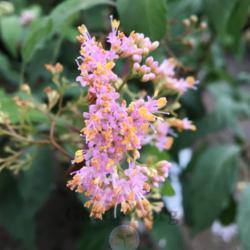American Beautyberry is an attractive deciduous shrub that attains heights to 6'. Tiny pink flowers appear in spring and early summer, followed by tight clusters of deep purple berries in the fall that are a food source to birds and other wildlife. American Beautyberry prefers a shady location and is very drought tolerant.

I have some named varieties of Beautyberry growing in my garden, but one shrub managed to appear by itself. It has now grown big enough to flower and set those stunning berries. I think it is a bird-planted seedling, but really I can't tell any difference between it and the ones I bought at the nursery. Same stunning, vivid purple berries.

Commonly mixed with other callicarpa, especially Americana.

Although I love my callicarpa for its late season color, it gets much larger than the stated height of 3-4 feet and spread of 4-5 feet. Mine is at least 6 feet tall and 8-10 feet wide and has to be cut back each year. Here in southern Indiana, it begins to shine in the garden in August with tiny, light pink flowers all along the stems which the bees just love. Then the green berries turn to a vibrant magenta and last well into November.

The fall berries are very tiny but bunched in clusters all along the branches. Very vivid coloring. The plant flowers and sets berries from the oldest part of the branches as it grows out. So during the summer there are times when the back of the branch has berries forming while the tips of the branches are still in flower. I planted my Beautyberry shubs in order to attract backyard songbirds with the berries but the only type of bird I have even seen eat them are the Mockingbirds. I do find the fall berries really pretty.

American beautyberry generally grows 3-5 ' tall & is about as wide as it is tall. It can reach a height of 9' if the soil & moisture are optimum. It has long, loose, gracefully arching branches & can be considered sprawling by some. It bears the most striking glossy pink fruit in clusters that hug the branches at leaf axils. Fruit is borne in the fall & winter & is a favorite of birds; the Northern Bobwhite in particular. White tailed deer are quite fond of munching on the leaves. The leaves begin dropping in the fall, making the berries even more showy. It generally grows as an understory plant. It is found in a vast range of soil types & moisture conditions. American beauty berry is extremely drought tolerant & during periods of prolonged drought it may temporarily lose it's leaves as well as developing fruit in order to survive & arise anew. It can be severely pruned just before new growth begins in spring to encourage a more compact habit.

New foliage emerges white and then fades to a speckled mix of green and white. Pinkish-purple berries hang from fall into winter, adding winter interest.

Beautyberry (Callicarpa 'Purple Pearls') is a flowering, fruit-bearing, sun-loving shrub with multiseason interest. It sports pink blossoms in the early summer, abundant lavender-purple fruit in the fall, and purple foliage color in the autumn. A Proven Winner plant, 'Purple Pearls' is a cross between Callicarpa dichotema and Callicarpa kwangtungensis. Its upright growth makes it an easy addition to many garden areas.
